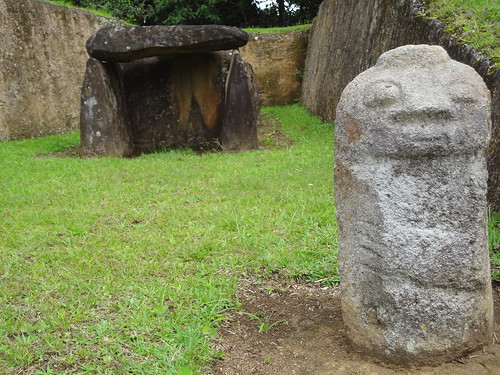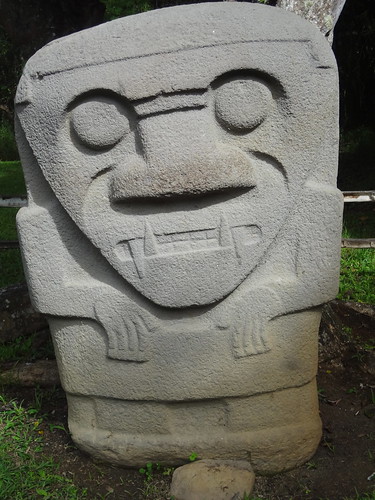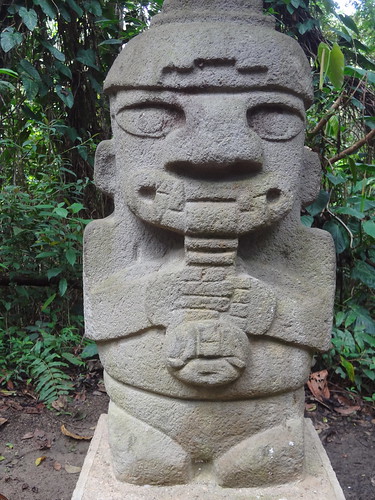Friday, March 30, 2012
Sculpture Club
In the hills surrounding the small Colombian town of San Agustin, there are the most remarkable remnants of a now extinct indigenous culture. Sometime between the first century AD and the eighth, they built hundreds of statues out of volcanic rock and placed them at burial sites.
There are statues of gods, and mythical creatures, and animals, and caricatured humans, some just over a foot tall, others tower at 13 feet.
It is an incredible archaeological site, and well worth the incredibly bumpy six hour bus ride along dirt roads to get there.
Wednesday, March 28, 2012
Mass Civilization = Minority Vulture
Last Saturday, I took a day trip to the Parque Nacional Purace a couple of hours outside of Popayan in southern Colombia. It is incredibly remote, and a bit of a pain in the arse to get to. After a weird conversation with the purveyors of bus tickets (they kept telling me that a scheduled later bus wasn't "seguro", which I now think, having seen the roads and the absolute lack of transport on them, meant that it wasn't a sure thing), I hopped on a bus at 6 am. Which meant I got to the nearby town of Purace a full hour before I was meant to meet my guide. Fortunately, she was flexible and we both ended up hitching a ride into the actual park with none other than "el jefe", the guy that runs the whole shebang. While there are many beautiful things to see in the park, like these sulphuric thermal springs bubbling up from the volcano...
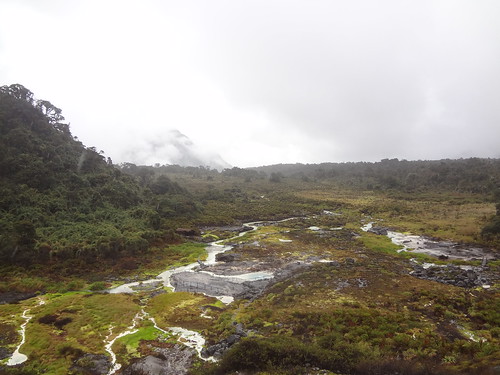
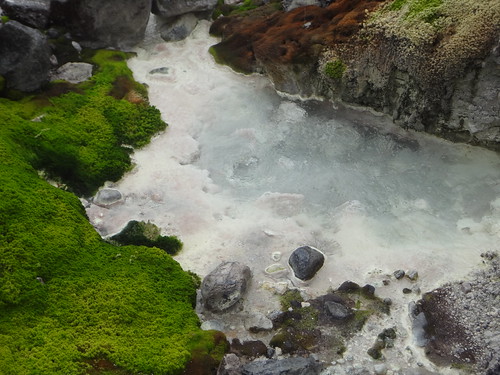
...there was one reason I really want to go to the Parque Purace. To see one of their three surviving Andean condors, some of the only wild condors in the whole country. Lonely Planet said that you can actually feed the condors with the park rangers on Saturday morning, which is why I scheduled my trip last weekend. But alas, that isn't the case. Apparently, there is an ongoing dispute between the government and the local indigenous population regarding the feeding of condors, so they don't tell tourists when the feedings occur. Fortunately, my guide was indigenous, and her friend brought along a pail of meat to set out on the feeding rock.

Then, we sat back to wait. About an hour later, a beautiful lady condor arrived. And while she never actually ATE anything, she did fly around our heads for about thirty minutes.
Condor in Parque Purace, Colombia from Tina Cone on Vimeo.
And I have a confession. While that lovely condor was flying overheard, it wasn't Simon & Garfunkel that I heard in my head. Instead, all I had in my brain, on repeat, was this:
Did anyone else love that cartoon as much as I did in the eighties?


...there was one reason I really want to go to the Parque Purace. To see one of their three surviving Andean condors, some of the only wild condors in the whole country. Lonely Planet said that you can actually feed the condors with the park rangers on Saturday morning, which is why I scheduled my trip last weekend. But alas, that isn't the case. Apparently, there is an ongoing dispute between the government and the local indigenous population regarding the feeding of condors, so they don't tell tourists when the feedings occur. Fortunately, my guide was indigenous, and her friend brought along a pail of meat to set out on the feeding rock.

Then, we sat back to wait. About an hour later, a beautiful lady condor arrived. And while she never actually ATE anything, she did fly around our heads for about thirty minutes.
Condor in Parque Purace, Colombia from Tina Cone on Vimeo.
And I have a confession. While that lovely condor was flying overheard, it wasn't Simon & Garfunkel that I heard in my head. Instead, all I had in my brain, on repeat, was this:
Did anyone else love that cartoon as much as I did in the eighties?
Sunday, March 25, 2012
Cathedrals, Colonialism and Cocaine
 |
| Catedral de Sal |
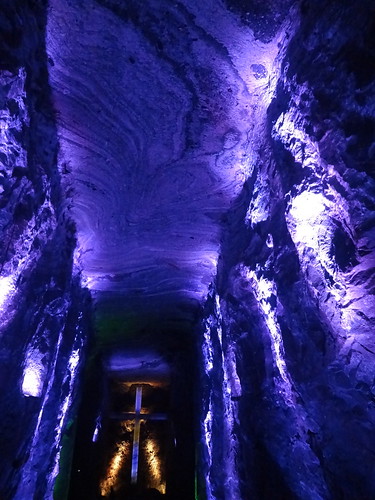 |
| the amazing roof of the cathedral de sal |
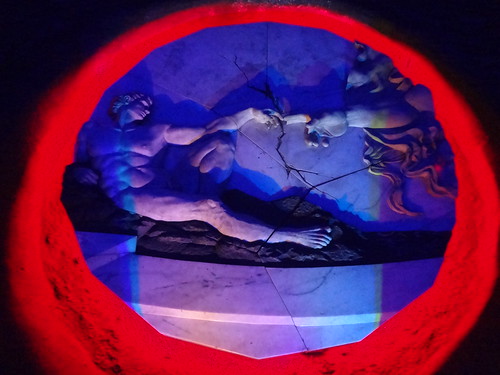 |
| God & Adam in the Catedral de Sal |
 |
| Plaza Mayor in Villa de Leyva |
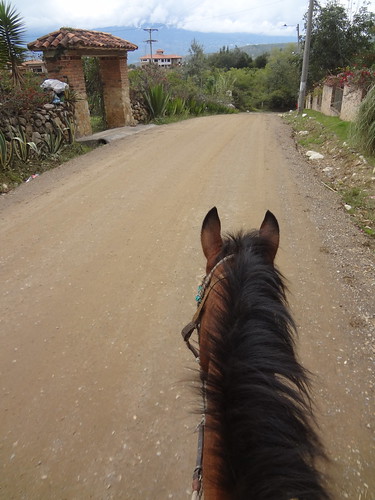 |
| Salta, my very patient horse, taking me out of Villa de Leyva |
 |
| Pozos Azules |
 |
| Me and my guide, Sebastian |
 |
| Plaza Bolivar, Tunja |
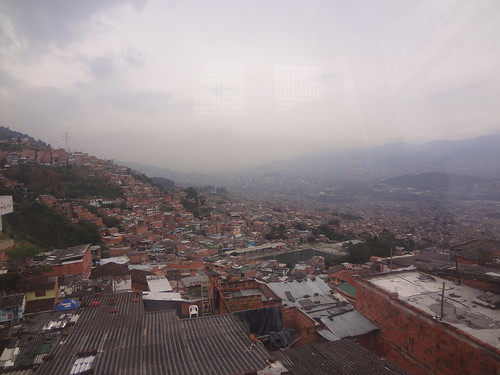 |
| Medellin |
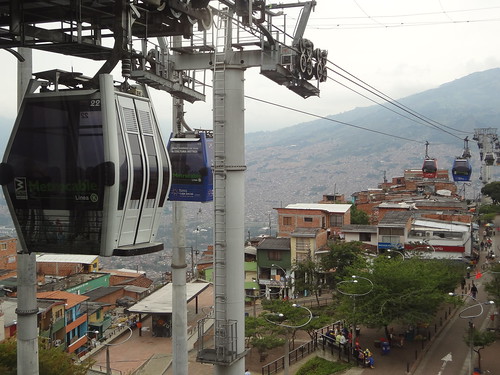 |
| one of Medellin's metro lines! |
 |
| The Death of Pablo Escobar - Fernando Botero |
 |
| the grave of Pablo Escobar (and company) |
Thursday, March 22, 2012
The More You Know...
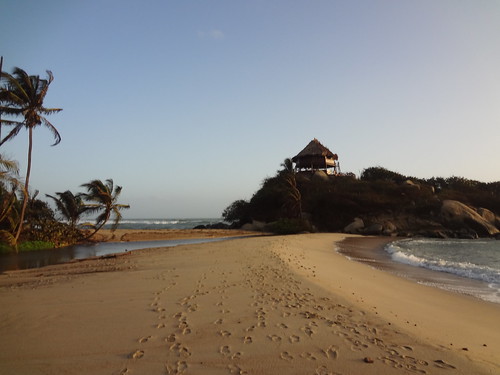 |
| parque tayrona: the "hammocks with a view" are in that open hut on the hill |
- You can be freezing cold on a beach in the summertime, if you happen to be sleeping on the beach in Parque Tayrona and you pay extra for the hammock with a view at Cabo San Juan. I only spent one night there and while the view was glorious, the wind wasn't. I ended up wearing all my clothes and a sleeping sheath while wrapped up in the hammock like a cigar - and still, I only managed to sleep about half an hour all night thanks to the gusting wind. By all means go to Parque Tayrona (it's gorgeous) and rent a hammock, but bring a sleeping bag or thermal gear with you.
- Travelling from Venezuela to Colombia by bus, you may need to pay a bribe. At least I did. There were several Venezuelan women on my bus who, between them, had something like 60 huge bags full of god knows what. As we were leaving the station in Caracas, one of them came down the aisle and asked everyone for 50 Bolivares each to pay off the soldiers at the road-side checkpoints so they wouldn't insist on rifling through our bags. I only had 20 Bolivares, which bribe-lady grudgingly accepted. We weren't stopped along the way, so maybe it actually worked.
- Colombia has the most amazing fresh fruit, and there are fruit stalls and juice stalls on every corner. As well as all the standbys like oranges, passionfruit, pineapples and guava, there are delicious fruits like Lulo and Guayaba and Zapote that I'd never heard of before arriving in Colombia. There are even some fruits, like the mouth-watering Nispero, that you can only find on Colombia's Atlantic Coast. I highly recommend trying as many as you can, but heads up to the lactose-intolerant: for some reason, Colombians like to add milk to their fresh fruit juices.
- A fake wedding ring doesn't always work to prevent unwanted advances. I thought that wearing a band on my left ring finger would automatically stop men from hitting on me, and mostly, it seems to have worked. Except for Oscar in Ciudad Bolivar who asked me why I couldn't have a Venezuelan boyfriend (ie. him) on the side, and Nelson in Santa Marta who kept asking when he could see me again, and the guy who claimed to be from Ireland (not a chance) who attempted to grab a snog in Ushuaia. But the one thing such men DID seem to care about? Was whether I had kids. So next time I travel to South America, I'm going to have to rent some.
 |
| at least a sleepless night meant i saw the sun rise over parque tayrona! |
Monday, March 19, 2012
Romancing the Cone
I haven't posted for a while for a very good reason:
My boyfriend Nick Ramsey joined me in Colombia for a week and we had an absolutely brilliant time together. First stop: Cartagena. We stayed at a very swanky hotel/spa called Karmairi that is on the beach about half an hour out of town. But our good friend Julia and her husband Elkin were staying in the old city so we spent plenty of time in there too. Cartagena is rightly considered one of the most beautiful cities in Colombia. The old town, with its balconies and colonial buildings, is incredibly picturesque.
It's surrounded by a wall, parts of which date back to the 16th century after Sir Francis Drake pillaged the city (sorry about that). On the upside, the wall makes a great place to watch the sunset.
Just outside the city, we visited the Volcan de Totumo, a volcano that oozes mud rather than lava. You climb up a rickety pair of stairs, then lower yourself INTO the volcano, then local villagers rub mud all over you. The mud is really thick and it makes you incredibly buoyant, so much so that we all had difficulty staying vertical rather than horizontal. Afterwards, you climb back down some even more rickety stairs and wash off in a nearby lake. It was a very strange and totally awesome experience, even though we were still picking mud out of our ears for days!
The next day, we all hopped on a boat to Playa Blanca, a gorgeous white sand beach about an hour away from Cartagena. We snorkeled, and ate a delicious fresh fish lunch, and cavorted in the sand. The only downside was the constant haranguing from local hawkers. Every two minutes, someone came up to ask if we wanted a drink, or a tchotchke, or some shellfish, or a massage. And the massage-hawkers would start rubbing my shoulders even as I was repeating "no, gracias" ad infinitum. Coming from the respect-my-personal-space capital of New York, I found it doubly weird. But those annoyances were pretty minor compared to the pleasures of the beach.
Not so minor? The sunburn that afflicted both of us. More on that in a moment. Fortunately we headed to Colombia's capital, Bogota, and Bogota is kinda like London. Very cosmopolitan, and very cloudy. We literally chilled out there, poodling around the colonial Candelaria district, taking a cable car to the top of Monserrate for a great view of the city, and eating delicious local tamales at La Puerta Falsa, surrounded by nuns!
For our final night, something far more irreligious. We travelled about an hour out of Bogota to a town called Chia and an insane restaurant/dance club/madhouse called Andres Carne de Res.
The place is HUGE, every square inch is covered in cherubs and art works and metal sculptures, the waiters all wear abattoir aprons and there are performance artists wandering the hallways.
After gorging ourselves on steak, and blood sausage, and chicken, and bacon, we were in no shape to hit the dance floor, but that didn't stop us people-watching until the wee hours of the morning. I've never seen anything like this place, and I cannot recommend it enough.
One final note on Bogota, and the aforementioned sunburn. Nick's back was still pretty raw by the time he needed to fly back to New York. So I went to the local drogeria to find some ointment and some gauze to mitigate the pain. As I was asking the pharmacist, in my terrible spanish, what would work best for sunburn, another customer stopped me, and pulled out her phone. She handed it to me and I found myself talking to her son Juan, who speaks English. After explaining what I needed, he offered to come down to the drugstore and help me in person. While we were waiting for him, the nice lady pulled out her phone AGAIN, and put me on the line with her daughter, Silvia, an english-speaking doctor at one of the best hospitals in Bogota. Silvia offered to look at Nick free of charge, and to prescribe whatever might be needed. Then Juan arrived and for the next twenty minutes, he translated between the pharmacist and myself, and sent me on my way armed with everything I needed and more.
Much like the bus station in Venezuela, I neither asked nor expected anyone except maybe the pharmacist to help me. And yet a stranger calls her children for me. One of them physically leaves his apartment to come help me and another one offers free medical care for my boyfriend. Nick didn't need or want to go to the hospital but if he DID, I had a doctor on standby. As it was, the gauze and ointment worked wonderfully and Nick made it back home to New York pain-free. All thanks to three strangers. Once again, I am so humbled, that words literally fail me.
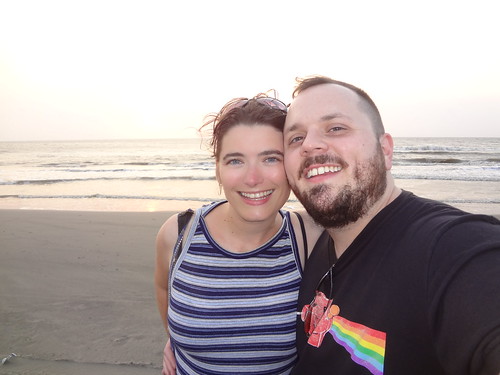 |
| Nick+me+beach=amazeballs |
My boyfriend Nick Ramsey joined me in Colombia for a week and we had an absolutely brilliant time together. First stop: Cartagena. We stayed at a very swanky hotel/spa called Karmairi that is on the beach about half an hour out of town. But our good friend Julia and her husband Elkin were staying in the old city so we spent plenty of time in there too. Cartagena is rightly considered one of the most beautiful cities in Colombia. The old town, with its balconies and colonial buildings, is incredibly picturesque.
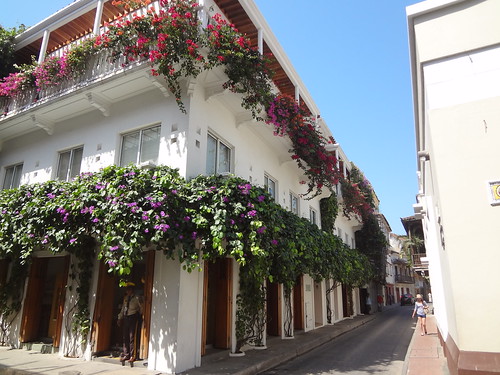 |
| Cartagena |
It's surrounded by a wall, parts of which date back to the 16th century after Sir Francis Drake pillaged the city (sorry about that). On the upside, the wall makes a great place to watch the sunset.
 |
| enjoying sunset on the wall |
Just outside the city, we visited the Volcan de Totumo, a volcano that oozes mud rather than lava. You climb up a rickety pair of stairs, then lower yourself INTO the volcano, then local villagers rub mud all over you. The mud is really thick and it makes you incredibly buoyant, so much so that we all had difficulty staying vertical rather than horizontal. Afterwards, you climb back down some even more rickety stairs and wash off in a nearby lake. It was a very strange and totally awesome experience, even though we were still picking mud out of our ears for days!
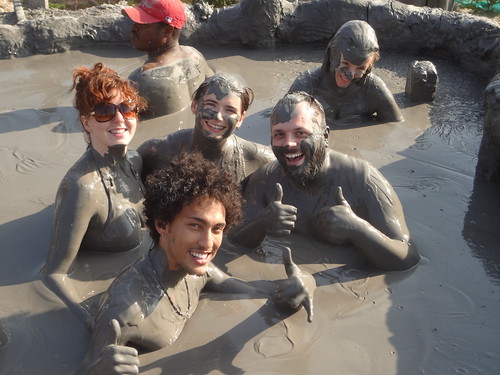 |
| the muddy four of us (plus some weird photo bomber in the back) |
The next day, we all hopped on a boat to Playa Blanca, a gorgeous white sand beach about an hour away from Cartagena. We snorkeled, and ate a delicious fresh fish lunch, and cavorted in the sand. The only downside was the constant haranguing from local hawkers. Every two minutes, someone came up to ask if we wanted a drink, or a tchotchke, or some shellfish, or a massage. And the massage-hawkers would start rubbing my shoulders even as I was repeating "no, gracias" ad infinitum. Coming from the respect-my-personal-space capital of New York, I found it doubly weird. But those annoyances were pretty minor compared to the pleasures of the beach.
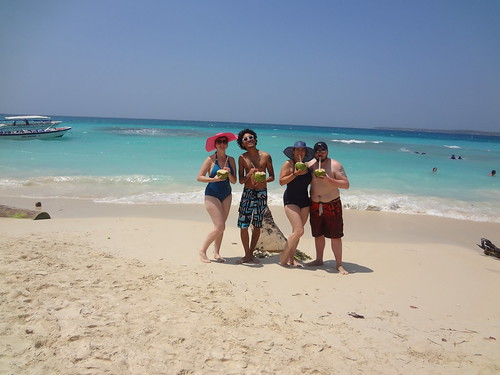 |
| living it up on playa blanca |
Not so minor? The sunburn that afflicted both of us. More on that in a moment. Fortunately we headed to Colombia's capital, Bogota, and Bogota is kinda like London. Very cosmopolitan, and very cloudy. We literally chilled out there, poodling around the colonial Candelaria district, taking a cable car to the top of Monserrate for a great view of the city, and eating delicious local tamales at La Puerta Falsa, surrounded by nuns!
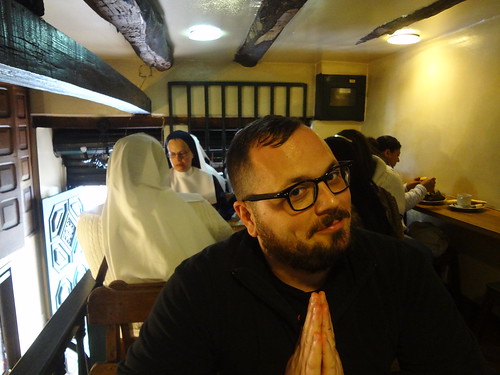 |
| Nick & the nuns |
 |
| this menu had nearly 100 pages |
The place is HUGE, every square inch is covered in cherubs and art works and metal sculptures, the waiters all wear abattoir aprons and there are performance artists wandering the hallways.
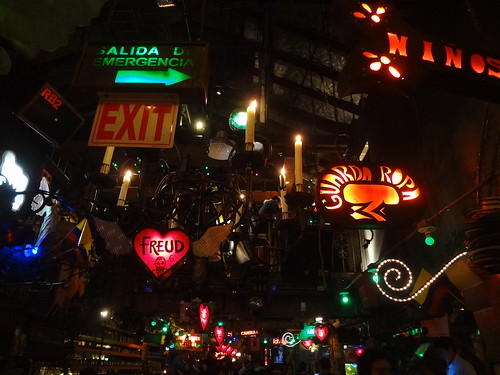 |
| Andres Carne de Res |
After gorging ourselves on steak, and blood sausage, and chicken, and bacon, we were in no shape to hit the dance floor, but that didn't stop us people-watching until the wee hours of the morning. I've never seen anything like this place, and I cannot recommend it enough.
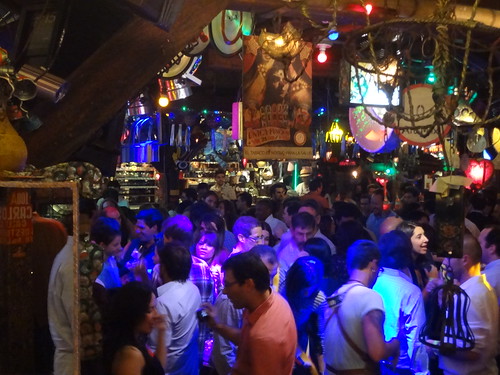 |
| 2am at Andres Carne de Res |
One final note on Bogota, and the aforementioned sunburn. Nick's back was still pretty raw by the time he needed to fly back to New York. So I went to the local drogeria to find some ointment and some gauze to mitigate the pain. As I was asking the pharmacist, in my terrible spanish, what would work best for sunburn, another customer stopped me, and pulled out her phone. She handed it to me and I found myself talking to her son Juan, who speaks English. After explaining what I needed, he offered to come down to the drugstore and help me in person. While we were waiting for him, the nice lady pulled out her phone AGAIN, and put me on the line with her daughter, Silvia, an english-speaking doctor at one of the best hospitals in Bogota. Silvia offered to look at Nick free of charge, and to prescribe whatever might be needed. Then Juan arrived and for the next twenty minutes, he translated between the pharmacist and myself, and sent me on my way armed with everything I needed and more.
Much like the bus station in Venezuela, I neither asked nor expected anyone except maybe the pharmacist to help me. And yet a stranger calls her children for me. One of them physically leaves his apartment to come help me and another one offers free medical care for my boyfriend. Nick didn't need or want to go to the hospital but if he DID, I had a doctor on standby. As it was, the gauze and ointment worked wonderfully and Nick made it back home to New York pain-free. All thanks to three strangers. Once again, I am so humbled, that words literally fail me.
 |
| Bogota |
Tuesday, March 6, 2012
The Tina Literary Supplement
I've spent a lot of time on buses, or waiting for buses, or waiting at hostels BEFORE waiting for buses. The pleasant by-product of all that waiting? Reading. Lots and lots of reading. Here's a quick look at what I've read so far (excluding an untold number of crappy romance novels that are my literary equivalent of crack-chocolate):
The Alchemist, Paulo Coehlo
The perfect book to read while traveling in South America. Written by Brazil's best-selling author, it's a rich fable about the importance of pursuing your dreams. Thanks for the affirmation, sir!
Various Poems, Pablo Neruda
Arguably Chile's most famous poet, his poems are extraordinary. And reading his works made me angry all over again about the treatment of his legacy under Pinochet.
Among Others, Jo Walton
I'm very sad to be missing book club at Word in Brooklyn, but very happy that I get to read their recommendations regardless. This was a charming fantasy/sci fi novel, not at all what I normally read so I was happy that Word once again pushed me outside my comfort zone.
World War Z, Max Brooks
This was such a compelling book about a zombie apocalypse that I read it in one straight sitting. It also had the added benefit of making me miss the Walking Dead a little less.
In the Garden of Beasts, Erik Larson
A fascinating account of the lives of the American ambassador and his family in Berlin during Hitler's rise to power, written by the same guy who brought us the excellent "The Devil in the White City".
Beatrice and Virgil, Yann Martel
A disturbing reminder of what happened under Hitler, Martel examines the Holocaust using a play (featuring a howler monkey and a donkey) within a book. I'm not sure I really got this one.
Galapagos, Kurt Vonnegut
Every time I read Vonnegut, I realize how much I enjoy reading him, and wish I'd read more of his books. This book did not disappoint: a darkly hilarious look at humankind and evolution.
Feeding on Dreams, Ariel Dorfman
The fabulous Jill Kitchen gave me this book, and I'm very happy she did. While I found Dorfman's style a little precious, his account of life in exile after Pinochet took power in Chile was fascinating.
The Lost City of Z, David Grann
A journalist on the trail of twentieth century explorers who hunted for El Dorado in the Amazon rainforest. Totally compelling, especially when you are reading it while exploring said rainforest!
The Big Short, Michael Lewis
Despite reading this excellent tome and others about the financial crisis (like Matt Taibbi's Griftopia), I still don't get exactly what all the financial devices used to screw the economy WERE. Which I think is part of the point.
The Night Circus, Erin Morgenstern
Lots of magic, doomed romance, and the world's most remarkable circus; what's not to love? I devoured this book.
The Tiger's Wife, Tea Obreht
Another gift from the lovely Jill Kitchen, and once again, spot on! I can completely understand why this keeps ending up on "best books of 2011" lists, it is a marvelous and magical piece of fiction.
The Orphan Master's Son, Adam Johnson
A fictional story set in an all too believable North Korea, this book was imminently readable and totally compelling to boot.
Moonwalking with Einstein, Joshua Foer
A journalist goes to cover the World Memory Championships and ends up so fascinated, he becomes a mnemonist himself and wins the US championship. A riveting read, with the added benefit of an education about what memory actually is, and how we can improve it.
The Hare with the Amber Eyes, Edmund de Waal
My Mum recommended this ages ago and I finally got to read it on this trip. It is a fascinating look at early twentieth century France, 1930's Vienna and post world war two Japan, all told through one family and their collection of Netsuke. It's exactly the kind of historical prism I seriously appreciate and I can't recommend this book enough.
Agorafabulous, Sara Benincasa
A comedienne recounts her debilitating panic attacks that literally left her unable to leave her flat or use the bathroom. Her style wasn't exactly my cup of tea, but kudos for writing about such a difficult time in her life.
Unlikely Allies, Joel Richard Paul
The great Kent Jones recommended this to me years ago, and I'm so glad I finally got to read it. It's the (true) story of how three people, a playwright, a cross-dresser, and a merchant, all pivotally contributed to the success of the American Revolution. I love this kind of undercovered history!
State of Fear, Michael Crichton
A pretty ballsy book to write - he basically calls global warming guff. I'm not as immersed in all the different scientific journals as Crichton is but I'm always pro healthy and informed skepticism, no matter how unpopular.
State of Fear, Michael Crichton
A pretty ballsy book to write - he basically calls global warming guff. I'm not as immersed in all the different scientific journals as Crichton is but I'm always pro healthy and informed skepticism, no matter how unpopular.
Right now, I'm simultaneously reading three different books:
Cloud Street, Tim Winton (an Australian novel recommended by my love, Nick Ramsey, that is, so far, riveting)
The Pilgrimage, Paolo Coehlo (a surreal fictionalized account of a modern pilgrimage on the Road to Santiago)
Thinking Fast and Slow, Daniel Kahnemann (a brilliant look into how our brains work and why people are biased)
I also have the following books to tide me over for a few weeks:
Multiculturalism, Ali Rattansi
Open City: A Novel, Teju Cole
Woodsburner: A Novel, John Pipkin (another Word book club book!)
The Sense of an Ending, Julian Barnes
The Astral: A Novel, Kate Christensen
And if all else fails, I have Crime and Punishment. Which should keep me busy for the rest of the trip if need be!
Sunday, March 4, 2012
A lesson from Venezuela
This is the bus station in Ciudad Bolivar, Venezuela. It's a pretty sketchy place, especially after all the little shops close up at 9pm. But it is the departure point for all buses to Caracas, so it was where I needed to be. I had specifically booked a seat on the 9:15pm Aeroexpresos Ejecutivos bus that arrives in Caracas nine hours later. The company has its own terminal in a nice part of Caracas, and given that I'm a girl, I'm traveling alone and I'm spanish-language-challenged, I did NOT want to find myself at one of the capital city's less salubrious bus stations, at dawn, exhausted, trying to find a cab that wouldn't rob me.
So there I was, sitting in the Ciudad Bolivar bus station on Thursday night. All was going well, until the 9:30pm bus showed up. Passengers waiting for the 9:15pm bus got extremely agitated and several stormed off to the ticket office, with me trailing in their wake. There was only one attendant working there, and by the time I reached her, she was surrounded by upset Venezuelans. Amidst the wild gesticulating and extremely rapid spanish, I managed to learn that the 9:15pm bus had been involved in some kind of unspecified accident and was completely cancelled. I quickly asked the attendant if my ticket would be good for the following night (the answer was yes). Then, noticing that everything in the station was suddenly closed up, including the phone bank, I dashed off to try and figure out how I could call the Posada La Casita where I'd been staying so they could pick me up.
I was pretty scared at this point. It's one thing to be alone, waiting on a bus, with a whole bunch of other people in a busy bus station, no matter how seedy that station is. It's quite another to be alone, in a rapidly deserting bus station, in a bad part of town, with no phone, no internet and very poor language skills.
But that is when something remarkable happened. One kid, noticing my desperation, quickly led me to a working telephone and I successfully reached the Posada. I stammered my thanks to the kid, and gave the telephone owner a couple of Bolivares to cover the cost. Then, as I headed towards the parking lot to wait for the pick-up, another Venezuelan guy stopped me. Noticing my blank look, he switched from Spanish into English and told me that I needed to get the attendant at the ticket office to change my now defunct ticket for a new ticket immediately, otherwise it might not be valid the next day. He even showed me what she'd written on his ticket so I knew what to ask for. After thanking him, I went back to the ticket office and got the attendant to make the change on my ticket. Then a lady stopped me, gesticulating that I needed a stamp on the ticket to make it official. She then proceeded to badger the attendant on my behalf until my ticket was properly accredited. I thanked her, and moved back toward the parking lot. There, yet another lady stopped me, and asked repeatedly if I had someone to pick me up from the station, if I was going to be okay, if I needed any help. She even waited there by my side until Oscar from the posada arrived to whisk me back to safety.
That was four different strangers who each took it upon themselves to help me without me ever asking a single one of them for help. Four strangers who noticed that I probably didn't have a clue what was going on, that I was a foreigner, alone and stranded in a dodgy place. Four strangers who took it upon themselves to approach me and help me out and make sure I was safe. I have never been so humbled in my life.
As my adrenaline levels started returning to normal, I realized that I'd never seen such a thing happen in London or New York. Yes, if people ask you for help, of course you help. But it never even occurred to me, whenever subways shut down, or trains were delayed, or buses were cancelled, to look around and see if any of my fellow would-be passengers were in trouble. If any of them were foreigners who had no idea how things work in the US. If any of them didn't know how to ask for help, but desperately needed it. But I tell you what, I will definitely be keeping an eye out for them from now on.
Subscribe to:
Posts (Atom)

